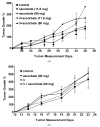Synthesis and Evaluation of Folate-Conjugated Phenanthraquinones for Tumor-Targeted Oxidative Chemotherapy
- PMID: 27066312
- PMCID: PMC4825697
- DOI: 10.4236/ojmc.2016.61001
Synthesis and Evaluation of Folate-Conjugated Phenanthraquinones for Tumor-Targeted Oxidative Chemotherapy
Abstract
Almost all cells are easily killed by exposure to potent oxidants. Indeed, major pathogen defense mechanisms in both animal and plant kingdoms involve production of an oxidative burst, where host defense cells show an invading pathogen with reactive oxygen species (ROS). Although cancer cells can be similarly killed by ROS, development of oxidant-producing chemotherapies has been limited by their inherent nonspecificity and potential toxicity to healthy cells. In this paper, we describe the targeting of an ROS-generating molecule selectively to tumor cells using folate as the tumor-targeting ligand. For this purpose, we exploit the ability of 9,10-phenanthraquinone (PHQ) to enhance the continuous generation of H2O2 in the presence of ascorbic acid to establish a constitutive source of ROS within the tumor mass. We report here that incubation of folate receptor-expressing KB cells in culture with folate-PHQ plus ascorbate results in the death of the cancer cells with an IC50 of ~10 nM (folate-PHQ). We also demonstrate that a cleavable spacer linking folate to PHQ is significantly inferior to a noncleavable spacer, in contrast to most other folate-targeted therapeutic agents. Unfortunately, no evidence for folate-PHQ mediated tumor regression in murine tumor models is obtained, suggesting that unanticipated impediments to generation of cytotoxic quantities of ROS in vivo are encountered. Possible mechanisms and potential solutions to these unanticipated results are offered.
Keywords: Cancer; Folate Receptor; Reactive Oxygen Species.
Figures








Similar articles
-
Chemotherapeutic drug delivery to cancer cells using a combination of folate targeting and tumor microenvironment-sensitive polypeptides.Biomaterials. 2013 May;34(16):4137-4149. doi: 10.1016/j.biomaterials.2013.02.014. Epub 2013 Mar 1. Biomaterials. 2013. PMID: 23453200
-
Assessment of the toxicity of mixtures of copper, 9,10-phenanthrenequinone, and phenanthrene to Daphnia magna: evidence for a reactive oxygen mechanism.Environ Toxicol Chem. 2006 Feb;25(2):613-22. doi: 10.1897/05-256r.1. Environ Toxicol Chem. 2006. PMID: 16519326
-
Effect of scavengers of active oxygen species on cell damage caused in CHO-K1 cells by phenylhydroquinone, an o-phenylphenol metabolite.Mutat Res. 1994 Jul;324(3):121-31. doi: 10.1016/0165-7992(94)90056-6. Mutat Res. 1994. PMID: 7517511
-
Discovery and development of folic-acid-based receptor targeting for imaging and therapy of cancer and inflammatory diseases.Acc Chem Res. 2008 Jan;41(1):120-9. doi: 10.1021/ar7000815. Epub 2007 Jul 27. Acc Chem Res. 2008. PMID: 17655275 Review.
-
Folate receptor-targeted immunotherapy of cancer: mechanism and therapeutic potential.Adv Drug Deliv Rev. 2004 Apr 29;56(8):1161-76. doi: 10.1016/j.addr.2004.01.009. Adv Drug Deliv Rev. 2004. PMID: 15094213 Review.
Cited by
-
Folic Acid-Peptide Conjugates Combine Selective Cancer Cell Internalization with Thymidylate Synthase Dimer Interface Targeting.J Med Chem. 2021 Mar 25;64(6):3204-3221. doi: 10.1021/acs.jmedchem.0c02107. Epub 2021 Mar 12. J Med Chem. 2021. PMID: 33710891 Free PMC article.
References
-
- Watson MB, Lind MJ, Cawkwell L. Establishment of in-Vitro Models of Chemotherapy Resistance. Anti-Cancer Drugs. 2007;18:749–754. http://dx.doi.org/10.1097/CAD.0b013e3280a02f43. - DOI - PubMed
-
- Apel K, Hirt H. Reactive Oxygen Species: Metabolism, Oxidative Stress, and Signal Transduction. Annual Review of Plant Biology. 2004;55:373–399. http://dx.doi.org/10.1146/annurev.arplant.55.031903.141701. - DOI - PubMed
-
- Slauch JM. How Does the Oxidative Burst of Macrophages Kill Bacteria? Still an Open Question. Molecular Microbiology. 2011;80:580–583. http://dx.doi.org/10.1111/j.1365-2958.2011.07612.x. - DOI - PMC - PubMed
-
- Sun Y, Colburn NH, Oberley LW. Depression of Catalase Gene Expression after Immortalization and Transformation of Mouse Liver Cells. Carcinogenesis. 1993;14:1505–1510. http://dx.doi.org/10.1093/carcin/14.8.1505. - DOI - PubMed
-
- Oberley TD, Oberley LW. Antioxidant Enzyme Levels in Cancer. Histology and Histopathology. 1997;12:525–535. - PubMed
Grants and funding
LinkOut - more resources
Full Text Sources
Other Literature Sources
